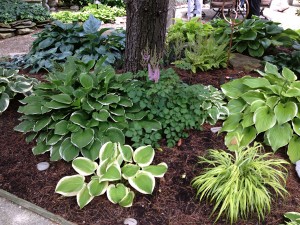In agriculture the Thistle is the recognized sign of untidiness and neglect, being found not so much in barren ground, as in good ground not properly cared for. It has always been a plant of ill repute among us; Shakespeare classes ‘rough Thistles’ with ‘hateful Docks,’ and further back in the history of our race we read of the Thistle representing part of the primeval curse on the earth in general, and on man in particular, for – ‘Thorns also and Thistles shall it bring forth to thee.’ — A Modern Herbal, Mrs. M. Grieve
Last year was the Year of the Thistles. No matter how much I pulled, chopped, dug, or crushed, the blankety-blank thistles would not die. In fact, for every one I killed, ten came to the funeral. Even the drought didn’t kill them. We tried mulching but the beasts laughed at our attempts to smother them. I hate thistles — they have an attitude.
This year in the vegetable garden, we have weed barrier fabric down, which has cut down on weeds in general, but those little cracks and spaces have filled with a variety of weeds: nutsedge, ground ivy, curly dock, chickweed . . . and some thistles. Not as many as last year, to be sure, but still some.
Corn gluten weed suppressant is a natural alternative to chemical herbicides, but it can’t be used if you are planting seeds. It prevents weed seeds from germinating, but it does nothing for weeds that come up from creeping root systems. It doesn’t seem to work on thistles that I’ve noticed. Only a sharp hoe and gloved hand yanking them out by the roots seems to do the trick.
The Irvington Garden Tour was an abject lesson in weed-free living and fabulous landscaping choices. The eight gardens full of healthy hostas and vibrant verbena, whimsical fairy set-ups and innovative fountains made me envious and depressed in equal measures. I came home and gazed at my pathetic attempts to make the world a more beautiful place, then went inside and curled up on the couch in defeat.
At FoodCon over at the Harrison on July 5, Shawndra Miller, who is a wonderful writer on all things natural and peaceful, had a booth where she made a “weed salad” with foraged greens and berries. It looked tasty and fresh, and I recognized many of the weeds in the bowl as plants growing in my garden. Perhaps, I thought, I’m looking at this the wrong way. Perhaps I’ll make a salad of the lamb’s quarter and whatnot that keeps coming back, and throw in a few volunteer mulberries that have managed to come up in the fence. A little nice organic olive oil, a little this and that, and I could have a nice little crunchy meal. Perhaps I could make friends with the weeds, er, undocumented and unauthorized greens.
And then I saw a baby thistle poking through the dirt among the beets, and I thought better of biting into that bristly plant, even though I’m sure it would be good for me. While I may nibble on some other stuff from the garden, I draw the line in the dirt at thistles.



